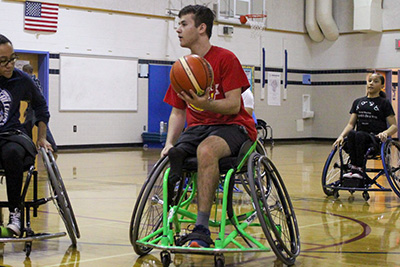This section starts with Common Questions about why we as patients are involved with making a surgical decision. The Five Steps to Making the Decision are some of the most important things osteosarcoma patients and parents thought new families should know. Making the Decision with Your Child answers questions many families have about how to involve their child in the decision.
Common Questions
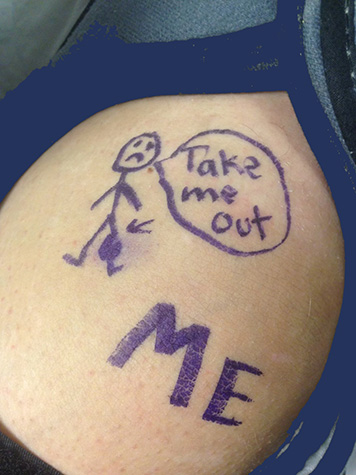
Why am I making a surgical decision?
You might be wondering, “Why would I make a surgical decision? I’m not a doctor.” Patients are often asked to help make a medical decision when there is no right or best decision based on the location or size of the tumor, stage of cancer, or age.
If survival is not affected by the surgical decision, then you can help decide which surgery is best for you. Not making a decision or “watching and waiting” is not an option with bone tumors. The tumor must be removed. A decision for the type of surgery after the tumor is removed will be made by someone.
What is shared decision making?
Shared decision making happens when you share how you want to live your life and your doctor shares what they know about the options for surgery. You are an expert in you, and your doctor is an expert in medicine. You and your doctor are both experts bringing your knowledge to the table for this decision.
Some doctors still decide what they think is best for their patient. Other doctors want their patients to make the decision on their own without any input from the medical team. Neither of these are shared decision making.
What is a decision aid?
A decision aid is a resource to help you understand the pros and cons of different options. It will help you think about the activities that enrich your life, or what matters most to you. Decision aids can be online, like this one, or as a paper version.
Decision aids can also include patient stories to learn more about what life has been like for others who made these decisions. Quotes from patients are highlighted throughout this decision aid. In many of those quotes, the surgical options have been shortened so that amputation is AMP, limb salvage surgery is LSS, and rotationplasty is RP.
This decision aid focuses on learning about the options with your surgeon, with other people who have made similar decisions, and in your own family.
The best use of this decision aid is to start at the beginning and work through the four sections: Making Your Decision, Know Your Options, You & Your Surgeon, and Life After Surgery.
When we looked at the Facebook page, there were some people there who were pretty insistent that if you do a limb salvage surgery, you were increasing the likelihood that the cancer will return. That was always our first question to every physician we met with. They were all insisting that was not the case. Whether we do a limb salvage surgery or rotationplasty or amputation was an orthopedic question. It would not impact the likelihood that this cancer would return. That was our primary concern at the time.
Questions to Ask Yourself About the Surgery
This decision aid is intended for you to use in discussions with your surgeon, not replace it.
Five Steps to Making the Decision
1
Know Your Options
Knowing your options is the focus of this decision aid. However, it is possible that one of the options may not be an option for you. This might be because of the location or size of the tumor, or the age of the patient. Generally, the three options for surgery for tumors in the knee joint area are: amputation, limb salvage surgery, and rotationplasty. If the tumor is further away from the knee joint, the options may differ.
If you learn about an option and think it’s a good one for you or your child, ask your surgeon about it. Not all surgeons can do a rotationplasty, so it might not be mentioned. Consider a second opinion if you are interested in a surgery that is not mentioned or supported by your team.
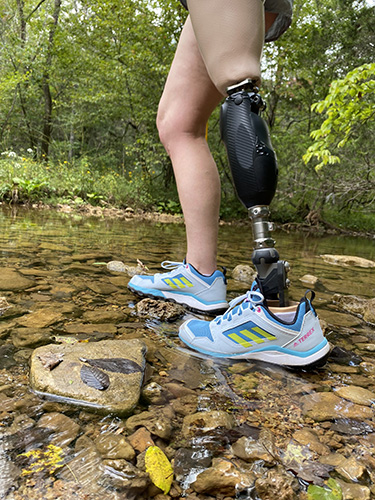
The most nuanced part of what we do is matching the right operation with the right patient. There are lots of options out there and all of those options probably will work fairly well. But if the patient doesn't want the option, then it doesn't work at all.
2
Talk to Your Surgeon
Discuss your specific case with your surgeon as the location of the tumor and the response to treatment will affect the success of limb salvage surgery. Sometimes amputation or rotationplasty is a better option. Present information about yourself or your child so they have a better understanding of what is important to you.
Ask questions and advocate for yourself or your child if a surgery you think is a good fit is not being discussed. Check your understanding of what the surgeon said to make sure there are not any misunderstandings. For example, what I hear you saying is that if I have a limb salvage surgery, I should not jump or run, is that correct? Express your concerns about options and explain why you think one option is better than another one.
Throughout my treatment, it was never a discussion with the orthopedic surgeon who treated me. It was always, “You’re going to have this and this is what we’re going to do.” I wish, at that time, I knew to voice my opinion more. As you go through it more, you learn you have to be your own advocate.
3
Talk to Others
Talk to bone cancer survivors in the social support groups about the surgical option they choose. Many people there are long-term survivors and are considered expert patients. These groups are closely monitored by administrators who remove incorrect information.
The need for peer support from survivors and parents who have made the decision is often discussed and recommended in the osteosarcoma community. You can also ask your surgeon if there are other families you can talk to and meet with in person.
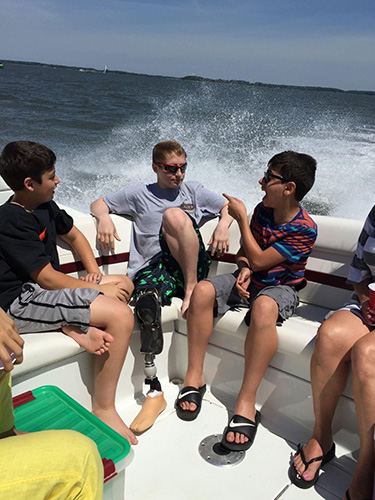
We did not meet with any amputees or people who have had rotationplasty. If that were available and I was able to meet with either the patients or the parents or family and talk to them, that would have been very helpful to me. I find the personal interactions very helpful… Face-to-face is always better, but cyberspace is second. I mean, just reading you can gather a lot of statistics, but you can tell a lot about how somebody feels by actually speaking with them and seeing them.
4
Consider What's Most Important to You
Consider what qualities in life matter most to you. We don’t often think about our values or what is most important to us until we are forced to make a major life changing decision – like the one you are making now. Review What Matters Most to You? Questions and Statements to think about what living a good life means to you. This may help you feel more comfortable with the final decision that you make.
Regardless of the decision made, patients often don’t return to the life they had but rather begin a new life that many people say is even better. Sometimes people refer to this as “a new normal.”

I think in this day and age, it’s so important to discuss quality of life past the surgery, not just the leg looking good and fixed, but what about in the future? How long is it going to last? What are you going to be able to do?
5
Understand the Uncertainty
How people do with the different surgeries over time is unknown. Some of the common questions people have are:
- What are the odds that if I choose limb salvage now, that I’ll still have an amputation later?
- If I choose amputation or rotationplasty, will I be able to be very active with my prosthesis?
- If I choose limb salvage surgery, how long will it be before I have another surgery?
These are questions that vary from person to person.
Researchers have not focused on what we call “patient reported outcomes” or what patients say about how they’re doing over time. Studies are often focused on how successful the surgeries appear to the surgeon. The structure of the implant might be considered a success from a surgeon’s perspective, but the patient might still seek an amputation due to chronic pain and/or limited mobility. It depends on your definition of success. Some people feel some amount of pain and surgery is worth it to keep their leg.
I would have loved to have known more information about how things could potentially turn out, what their experiences as a surgeon are. It wouldn’t have changed my mind, but I would have felt more comfortable with the openness.
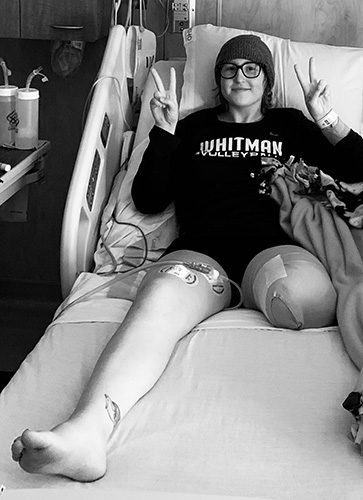
The decision is uniquely yours and your decision will be based on what’s most important to you. The purpose of this decision aid is help you feel knowledgeable about what can happen so you aren’t surprised later. This alone helps people feel more satisfied that they made a good decision, even though none of the options are ideal.
The decision for surgery is one decision but there will be more decisions to be made over time. Even rotationplasty and amputation are not “one and done” surgeries. Sometimes minor surgeries are needed later to address pain or for a more comfortable fit with a prosthesis. People with limb salvage may choose rotationplasty or amputation one year or many years after their first surgery.
Some people feel that the best surgery is the one that has the least complications for you or your child later. Unfortunately, doctors can’t predict who will have issues or complications, and who won’t. So choose a surgery you can live with because in most cases, you can’t go back.
Had I really had an understanding of the pain that my son would have to deal with on a daily basis, I may have made a different decision…I think it really compromises the quality of his every day. Sometimes, he might have a few bad days in a row. I don’t know if I could have wrapped my head around that even if they said it. I’m not sure that we would have made the same decision. I don’t know. Then again, I see people online who say they have no pain at all. Then, some people say, “No. I have pain every day.” So, I think it’s really split. I don’t know if the surgeon really knows. I think they’re really focused on what they can do with the affected bone and leg, and that’s what they’re going to do. I guess I think the more information you have, the better equipped you are to make a decision. So, I think I would have liked him to say, to have told us more about that possibility.
Making the Decision with Your Child
There is no magic age for when a child can be engaged in making the decision, but many families want their child to have some control over what their future will be like. People who participate in making medical decisions are generally more satisfied with the results and they have fewer regrets. It may be harder to accept a child’s decision if it’s not what the parents would have chosen for them.

They have to have some say. It's their body.
I’m glad that my father had mentioned that. I think the most beneficial factor out of that for parents is making sure their kids have a choice. Obviously if your kid’s three years old, they’re not going to have any idea of what to say and how to react. If your kid is 10 or 12 or 14 years old, I think it’s very imperative that they allow them to have some type of say and make sure everything is explained in detail about what’s going on.
It’s especially hard for parents to make the surgical decision for a child who can’t or doesn’t want to be involved in making the decision. Parents struggle with making the right decision and not the wrong decision. Looking back on this decision, both families and surgeons want future families to understand there is no one right decision. If there were, we would all choose that one, right?
Patients need to know that there's no perfect easy option that maximizes everything. If there were, we would just do that thing and move along. This is a "1 size fits 1" endeavor and families need to know that they will be presented with several imperfect options, from which they will choose the one that they think sucks the least. There is no escaping the suck altogether.
Younger children may find it helpful to have dolls with prosthetic limbs. There are several options that embrace diversity so you can find one that best fits your family.

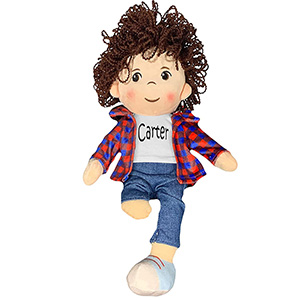

There are several dolls on Amazon with prosthetic legs and new ones are being added. You can even order a custom boy or girl doll that looks like your child such as custom dolls with prosthetics.
This decision aid is intended to provide you with the most comprehensive information available for you to make a knowledgeable decision for you or your child at this point in time. There may come another point in time where another decision will have to be made but that doesn’t mean you made the wrong decision the first time.
I was trying to think about how my son would feel. I never thought about anything else but that really, how he would feel about how he looked or what he could do. Really, up until the day before surgery, I was really conflicted. We all were. It’s just too overwhelming.
Supporting Your Child's Decision-Making Preference
Although there is no specific age at which a child is mature enough to be involved in the decision, the American Academy of Pediatrics says that children should be involved in decisions about their care. In general, patients who participate in making the decision feel better about the outcome, even if it’s not everything they expected.
One parent said their daughter’s surgeons said she was “only 14 and doesn’t have the ability to make the choice.” Another parent said their surgeon told them their 14-year-old needs to be involved in making the decision. Ultimately, it’s up to you and your child to decide at what level they can and want to be involved. You might share this decision aid with your child to help them understand the options.


Some parents let young children decide while others make the decision for an older teen, if that is what the teen prefers.
We told him what was going on. He really deferred and relied on us. He didn’t want to be involved in the decision. So, he had very limited participation. We invited him and certainly wanted to hear what he was thinking. He just wanted us to make decisions and be told what he had to do.
Often parents let the child take the lead in deciding how involved they want to be.
She would ask us, “Well, this is what I want to do, do you think that’s a good decision?” We would just say, “We feel like it’s your decision. Any decision you make is good.”
Some children and teens prefer to take the lead but like to hear what their parents think.
They had their opinions, but they let me make the decision on my own.
Some parents monitor their child’s decision but still want the decision to come from their child.
We really listened to our son, and we wanted this to be his decision. I think we kind of monitored his decision-making process. You know, we wanted to make sure he was making the decision the right way. That was what we cared more about.
The decision-making process is unique to each family and what works for one family may not feel comfortable in another family. Looking back on their experiences though, many patients wish they had been more involved in making the decision that would affect them for the rest of their lives.
I was, from my perspective, trying to think what my son would want if he were ten years older and looking back on it. You know? My son was not an athletic child. He didn’t play sports. That limitation made the decision easier. Because both of the doctors that we met with said my son is never going to play soccer with the limb salvage surgery. He’s probably not going to be playing baseball and other things...That wasn’t an issue for him, because he didn’t play those sports anyway.
Your Child & Their Surgeon

Children often don’t have much experience communicating with doctors. As a parent or caregiver, you can help your surgeon understand how your child wants to be involved in the decision. There is no magic age at which children can be involved in the decision, it’s up to you as a family to decide. Sometimes young children express clearly what they want, others prefer the surgeon and parents to make the decision for them.
Some children appreciate that surgeons include them in the discussions.
My parents were in the room, but he spoke directly to me and listened to me about everything. It seemed like he was more on me than my parents, which was nice.
Children may be feeling intimidated by the surgeon or anxious about their diagnosis.
These doctors did their best to speak directly to him. You know, they’re way older people that walk in with white lab coats. He’s already going through the scariest time in his life.
Surgeons can involve your child in the decision by sharing information about the surgery in a way they can understand. Ask your surgeon for visual aids to help them understand what to expect.
She brought all of this stuff in for me before, like the rod, the knee…let me play with it, let me feel it, explained in-depth pretty much what she was going to do. I always appreciated that. I really did.
Children can also be involved in ways that do not always involve active communication with the surgeon. They might be listening and gathering information at the medical appointment to look up on the internet later.
I just know he was immediately on his phone looking up to see what was going to happen to him. He wasn’t trusting the faces in front of him for some reason. It was better online.
